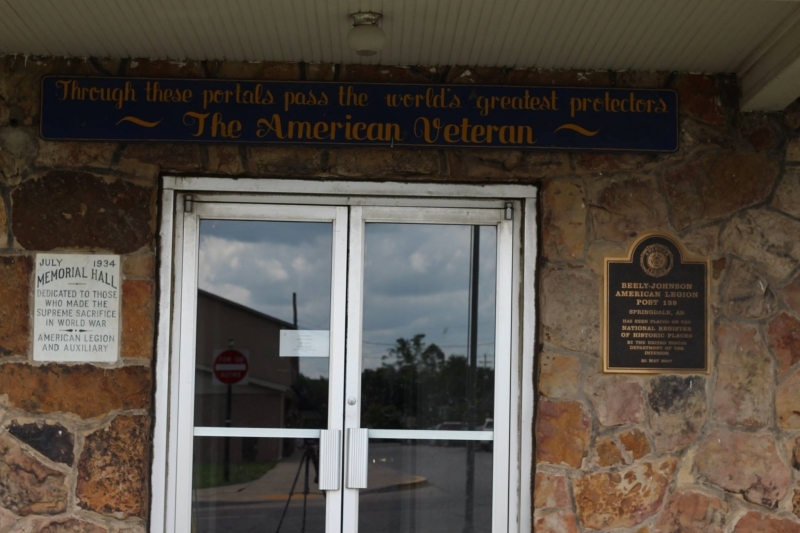
The construction of the American Legion Hut was one of Springdale's most memorable community projects during the Depression. A lifetime Springdale resident Harold E. Henson, a veteran of both World Wars, remembered the event as a "gallant effort by legionnaires and townspeople."
New Deal agencies such as the Civil Works Administration provided aid for the construction of Legion Huts and other municipal projects during the Depression. After considerable discussion, the Springdale Post decided that an effort should be made to acquire government aid in order to build a Legion Hut in the city. Henson and his wife Dolly accompanied a group of local Legionnaires and set out for Little Rock in Henson's old Model A Ford one night. They arrived at the capital the next morning.
The Springdale delegation reported to the Federal Building. They met Captain Limmerick, who was the state's coordinator and administrator of projects, and was a Civil Engineer for the Civil Works Administration. The group's proposal for a Legion Hut was rejected because of a lack of sufficient membership. In 1920, ex-servicemen of Springdale sent Fay Stafford to the American Legion Convention in St. Louis for information about establishing a post in Springdale.
The local post was organized the following year. The group moved to the lobby, held a conference, made up a list of Springdale's ex-servicemen they knew, and with their own money they paid the dues to the American Legion Headquarters. Henson took the new list in and had it approved for the project.
Following its approval, a campaign was launched for money, materials, and land for the construction of the proposed building. Labor was furnished by the government with wages running $1 per day. In 1927 the post leased the land from the city, where it still stands today.
In 1929 the plans began to come together for the building of a Post Hut. Henson remembered that the construction of the Legion Hut was off to a good start, with many local businesses and individuals donating their time and funds. But construction of the building was delayed by the Depression. During the summer of 1934, the hut was built.
Stone from the city's east mountain was used in the project. One resident, Henderson Scott, donated the use of his team of mules to drag rocks down the mountain to the main road, where trucks picked up the loads and transported them into town. A stone with the American Legion emblem on it was donated by Bryan Work, Vern Backus and A.A. Backus.
The list of all who helped this project become a reality is difficult, but a few of these hearty individuals were Luther Johnson, Sam Donahue, Albert Markley, Scott Main, Wilbur and Walter Atkins, and Byron Brogdon.
The post was dedicated on August 26, 1934, in honor of Springdale's first World War I victim, Clarence Edwin Beely. Beely was killed during the Meuse-Argonne battle on October 3, 1918. His body was returned in October 1921 and is buried about a half mile away in Bluff Cemetery.
In 1962 the post's charter was altered to read "The Beely-Johnson Post," honoring the late Elmer Johnson, Jr., a World War II veteran. Johnson died in Brittany, France, September 12, 1944.
Since its completion the building has been used by practically every social and civic group in the city. It has served as a meeting place for Boy and Girl Scouts, church classes, fruit growers, and as a voting place. The post has sponsored numerous projects including sending young people to Boys and Girls State; sponsoring the oratorical contest at the Springdale High School and presenting the coveted Outstanding Boy and Girl Citizen Award; and sponsoring the American Legion Baseball Program.
The Beely-Johnson Legion Post 139 was nominated to the National Register of Historic Places with local significance under Criterion A for its association with the American Legion and the Civil Works Administration in Springdale, Arkansas. It was also nominated to the National Register of Historic Places under Criterion C for its excellent fieldstone construction. The Beely-Johnson American Legion Post 139 was submitted under the multiple property listing, "An Ambition to Be Preferred: New Deal Recovery Efforts and Architecture in Arkansas, 1933-1943."
